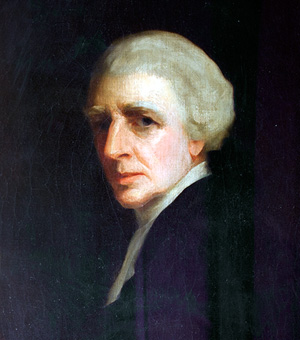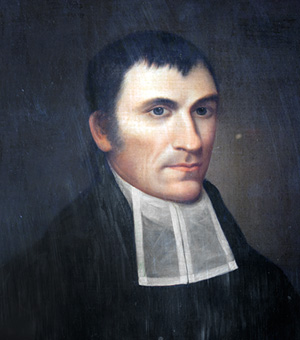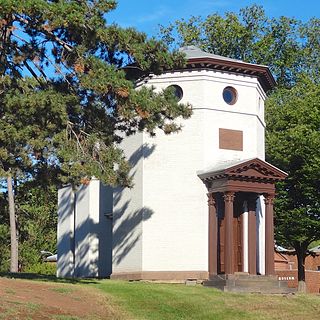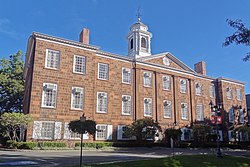
Rutgers University, officially Rutgers, The State University of New Jersey, is a public land-grant research university consisting of four campuses in New Jersey. Chartered in 1766, Rutgers was originally called Queen's College, and was affiliated with the Dutch Reformed Church. It is the eighth-oldest college in the United States, the second-oldest in New Jersey after Princeton University, and one of nine U.S. colonial colleges that were chartered before the American Revolution.

Jacob Rutsen Hardenbergh was an American Dutch Reformed clergyman, colonial and state legislator, and educator. Hardenbergh was a founder of Queen's College—now Rutgers, The State University of New Jersey—in 1766, and was later appointed as the college's first president.

Ira Condict was an American Presbyterian and Dutch Reformed minister who served as the third president of Queen's College in New Brunswick, New Jersey.

John Henry Livingston was an American Dutch Reformed minister and member of the Livingston family, who served as the fourth President of Queen's College, from 1810 until his death in 1825.

Philip Milledoler was an American Presbyterian and Dutch Reformed minister and the fifth President of Rutgers College serving from 1825 until 1840.

William Henry Campbell was an American Presbyterian minister and the eighth President of Rutgers College serving from 1862 to 1882.

New Brunswick Theological Seminary is a Reformed Christian seminary with its main campus in New Brunswick, New Jersey. It was founded in 1784 and is one of the oldest seminaries in the United States. It is a seminary of the Reformed Church in America (RCA), a mainline Reformed Protestant denomination in Canada and the United States that follows the theological tradition and Christian practice of John Calvin. First established in New York City under the leadership of the Rev. John Henry Livingston, who instructed aspiring ministers in his home, the seminary established its presence in New Brunswick in 1810. Although a separate institution, the seminary's early development in New Brunswick was closely connected with that of Rutgers University before establishing its own campus in the city in 1856. Since 1986, the seminary has also offered classes at a satellite location on the grounds of St. John's University in the Jamaica neighborhood of Queens, New York.

The First Reformed Church, historically known as the Dutch Reformed Church, is located in New Brunswick, New Jersey on 160 Neilson Street. It is adjacent to the First Reformed Church Cemetery in the churchyard. The education building is located next to the sanctuary building with the street address being 9 Bayard Street.

Voorhees Mall is a large grassy area with stately shade trees on a block of about 28 acres (0.11 km²) located on the College Avenue Campus of Rutgers University near downtown New Brunswick, New Jersey. An eclectic mix of architectural styles, Voorhees Mall is lined by many historic academic buildings. The block is bound by Hamilton Street, George Street (north), College Avenue (south) and Seminary Place (west). At the mall's western end, across Seminary Place, is the campus of the New Brunswick Theological Seminary, whose history is intertwined with the early history of Rutgers University. Across Hamilton Street is the block called Old Queens, the seat of the university.
Rutgers University is an institution of higher learning with campuses across the State of New Jersey its main flagship campus in New Brunswick and Piscataway, and two other campuses in the cities of Newark and Camden, New Jersey.

The Sophia Astley Kirkpatrick Memorial Chapel, known as Kirkpatrick Chapel, is the chapel to Rutgers, The State University of New Jersey and located on the university's main campus in New Brunswick, New Jersey in the United States. Kirkpatrick Chapel is among the university's oldest extant buildings, and one of six buildings located on a historic section of the university's College Avenue Campus in New Brunswick known as the Queens Campus. Built in 1872 when Rutgers was a small, private liberal arts college, the chapel was designed by architect Henry Janeway Hardenbergh at the beginning of his career. Hardenbergh, a native of New Brunswick, was the great-great-grandson of Rutgers' first president, the Rev. Jacob Rutsen Hardenbergh. It was the third of three projects that Hardenbergh designed for the college.

Geology Hall is a historic building on the Queens Campus of Rutgers University, in New Brunswick, New Jersey. It was built from April 1871 to June 1872 to house various science classes and the Rutgers Geology Museum. The museum was established in 1872 by George Hammell Cook, Rutgers' then professor of geology, with a collection of specimens whose assembly began in the 1830s under Cook's predecessor, Lewis Caleb Beck. As classes and offices moved out of the hall, the museum expanded until it occupied the entire hall by the mid-20th century. In 1973, the hall was added to the New Jersey and National Register of Historic Places (NRHP) with Old Queens, President's House, Van Nest Hall, Daniel S. Schanck Observatory, the Kirkpatrick Chapel, and Winants Hall as part of the Old Queens Campus historic district.

Alexander Johnston Hall is a historic building located on the corner of Somerset Street and College Avenue, New Brunswick in Middlesex County, New Jersey and is the second oldest building on the campus of Rutgers University. It was built in 1830 to handle the expansion of the Rutgers Preparatory School and the two literary societies, Philoclean and Peithessophian. The building, described using its historic name, Rutgers Preparatory School, was added to the National Register of Historic Places on July 18, 1975 for its significance in architecture and education.

The Daniel S. Schanck Observatory is an historical astronomical observatory on the Queens Campus of Rutgers University in New Brunswick, New Jersey, United States, and is tied for the seventh oldest observatory in the US alongside the Vassar College Observatory. It is located on George Street near the corner with Hamilton Street, opposite the parking lot adjacent to Kirkpatrick Chapel, and to the northeast of Old Queens and Geology Hall.

The Queens Campus or Old Queens Campus is a historic section of the College Avenue Campus of Rutgers, The State University of New Jersey in New Brunswick, New Jersey, in the United States.

Winants Hall is a historic educational building located on the Queens Campus of Rutgers University in New Brunswick, New Jersey. Designed by Van Campen Taylor and completed in 1890, Winants Hall is the oldest dormitory building at Rutgers University, known then as Rutgers College. The building was a gift to the university from Board of Trustees member and Bayonne businessman, Garrett E. Winants, and cost $75,000. The construction of the dormitory satisfied many long-awaited needs of the college. The new residential system also fostered a thriving social atmosphere for students, staff, and guests as it served as a student dormitory from 1890 to 1947.

A bronze statue of William the Silent was installed in 1928 on the Voorhees Mall section of Rutgers University's College Avenue Campus in New Brunswick, New Jersey. It is along Seminary Place, a street at the western end of the Voorhees Mall, and near several academic buildings, including the university's Graduate School of Education, Van Dyke Hall, and Milledoler Hall.

The Demarest House is a historic building at 542 George Street in New Brunswick, New Jersey on the campus of Rutgers University. It was documented by the Historic American Buildings Survey in 1960. The house was later added to the National Register of Historic Places on August 10, 1977 for its significance in architecture, education, and social history.
























